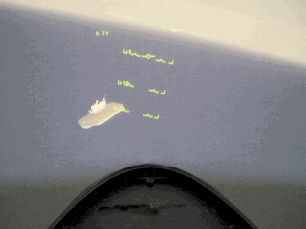
Over-Flight during the Alenia-Cetena simulation
Aldo Zini, Andrea Lommi, Riccardo Necrisi, Davide Tozzi
Cetena S.p.A. – Italian Ship Research Centre
Via Ippolito d’Aste 5
16121 Genova - Italy
E-mail: aldo.zini@cetena.it
Marco Raffa, Roberto Costa
Fincantieri - Cantieri Navali Italiani S.p.A.
Via Cipro 11
16129 Genova - Italy
E-mail: marco.raffa@fincantieri.it
Keywords: Virtual Prototyping, Virtual Reality Based Simulations, HLA, Ship Design
ABSTRACT
Until now, it has always been difficult to test the behaviour of a ship
in a particular working condition before building it or setting up a phisical
mock-up; however, building a prototype can be impossible or too expensive
in some industrial fields, to the extent that sometimes the cost of the
final product is heavily influenced by the phisical mock-ups that have
been built to test it. In this paper, the description of how HLA (High
Level Architecture) has been used by CETENA and Fincantieri to set up a
real time simulations is given; selected applications are reported in order
to demonstrate the capabilities of the developed simulation, also in case
of interconnection with other simulations.

Over-Flight during the Alenia-Cetena simulation
BIOGRAPHICAL NOTES
ALDO ZINI graduated in Electronic Engineering at Genoa
University in 1990. Since 1991 he has been working in CETENA dealing with
information technologies problems. In particular, he was involved in several
projects dealing with I.T. applications in shipbuilding and shipping areas:
CAD systems, Neural Networks, Ship Survivability Analysis, Virtual Prototyping,
Expert Systems, Database, dynamic WEB sites, technical computational code,
graphical interfaces.
He is participating to the NATO NG6 Specialist Team on Simulation Based
Design and Virtual Prototyping and to the NIAG Sub Group 60 on SBD &
VP.
He was involved as scientific responsible in several European research
Projects, among which HYDROSES and MATSTRUTSES. His present position is
Head of the Information Technology Department of CETENA.
ANDREA LOMMI received the Laurea Degree in Telecommunications
Engineering in 2001 from the University of Genova, discussing a Degree
Thesis entitled "Sidelobe Reduction in Sparse Linear Arrays by Genetic
Algorithms".
Currently, he works for CETENA S.p.A., Information Technologies Department,
where he applies Virtual Prototyping and stochastic optimizers to ship
design, optimization and performance assessment.
His main research interests are Virtual Prototyping, Virtual Reality
based Simulations, Adaptive Antenna Arrays, Antenna Arrays Synthesis and
Genetic Algorithms.
RICCARDO NECRISI graduated in Electrical Engineering in 1999 at University of Genova discussing a Degree Thesis "Electromechanical simulator of Hybrid Vehicle". He has been working for CETENA since September 2000 in the Information Technology Department. He is now involved in carrying out virtual prototyping and in researching technologies for vrtual reality application.
DAVIDE TOZZI was born in 1977 and graduated in Electronic Engineering in 2001 at the University of Genova, discussing a Degree Thesis entitled "Design and Realization of an intelligent system for ship motion prediction for Landing Period Designator" (D. Sterpi, D. Tozzi). At present he works for CETENA S.p.A., Information Technology Department, where he is working on the application of Virtual Prototyping in ship design and Virtual Reality based Simulations.
MARCO RAFFA graduated in Naval and Mechanical Engineering
in 1979, he started working with FEM software for structural analysis and
verification in FINCANTIERI. In 1985 he was responsible for the study and
implementation of the graphical system for functional and detailed design
based on commercial software with particular focus on the realization of
a complete 3D ship model. From 1990 to 1994 he has been responsible of
the hull building yard. This experience has been used from 1994 to 1998
in the hull design and manufacturing for the new fast ferries.
From 1998 he is responsible for the management and development of technical
information systems in FINCANTIERI DMM and he's nowadays directly involved
into the evaluation of cost/benefits deriving from the use of Virtual Prototyping
techniques in the ship design process.
ROBERTO COSTA qualified as a Naval Technician is working presently in Fincantieri -Cantieri Navali Italiani S.p.A as member of CAD Office in the Military Ships Division. He's involved in the support for software and information technologies architectural problems concerning the Project Management Area. Nowadays he's working on Virtual Prototyping development and testing for internal and Italian Navy's projects.